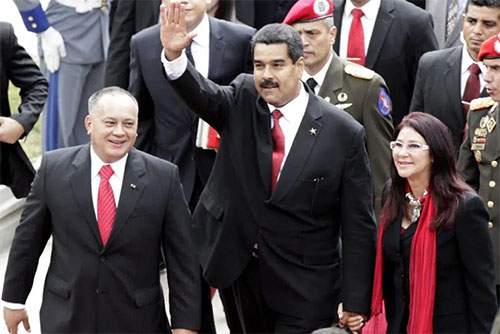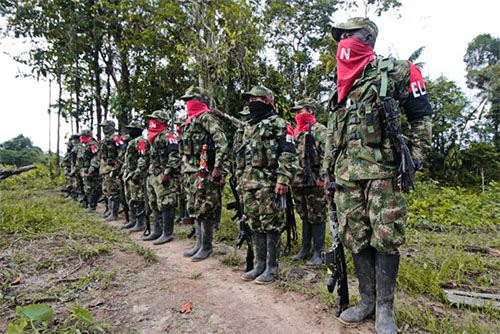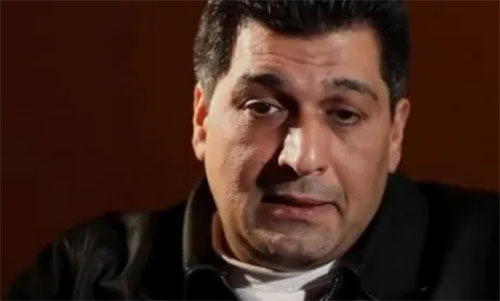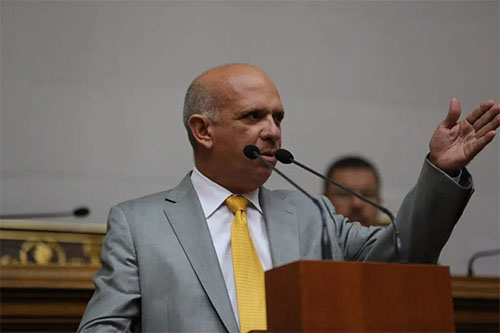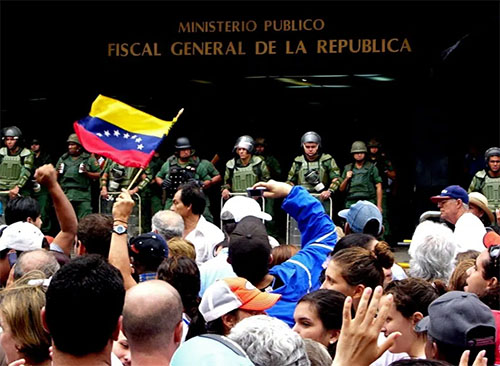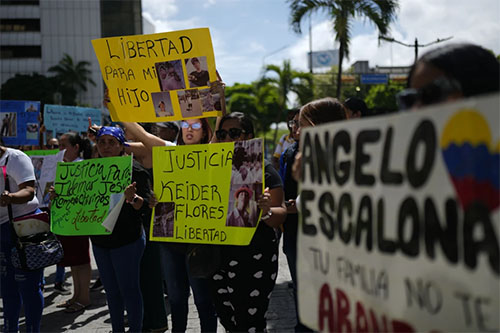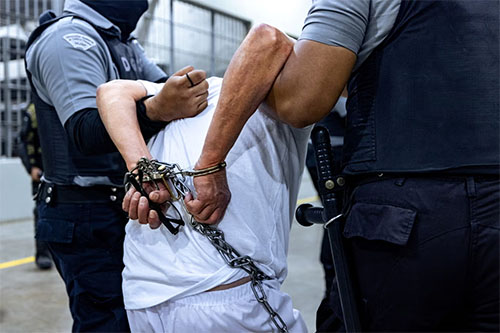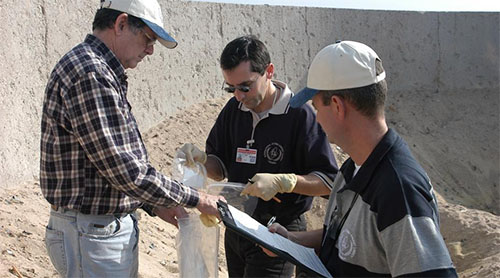by Jerry Dunleavy
Just the News.
Published: April 23, 2025 10:55pm
Updated: April 23, 2025 11:34pm
https://justthenews.com/government/secu ... classified
The leaders of the FBI and the Office of the Director of National Intelligence (ODNI) are insisting that the gang Tren de Aragua works in coordination with the regime of Venezuelan strongman Nicolas Maduro following “twisted” and “illegal” classified leaks which claimed that at least some spy agencies did not believe this to be the case.
ODNI's director, Tulsi Gabbard, and FBI Director Kash Patel were prompted to publicly argue that the Venezuelan gang — also called the Aragua Train or just TdA — is in fact linked to the Maduro regime after purported classified leaks in recent days. The leaks allegedly revealed the U.S. intelligence community’s National Intelligence Council cast doubt on the idea that TdA is cooperating with Venezuela’s socialist leader Maduro, the successor to dictator Hugo Chavez.
Leaks attempt to undermine Trump's stance
Over the weekend, the Washington Post cited unnamed “people familiar with the matter” when reporting that “the National Intelligence Council, drawing on the acumen of the U.S.’s 18 intelligence agencies, determined in a secret assessment early this month that the Venezuelan government is not directing an invasion of the United States by the prison gang Tren de Aragua.”
The outlet contended that “the intelligence product found that although there are some low-level contacts between the Maduro government and Tren de Aragua…the gang does not operate at the direction of Venezuela’s leader.”
The ODNI told the Post over the weekend that Trump "took necessary and historic action to safeguard our nation when he deported these violent Tren de Aragua terrorists” and that “now that America is safer without these terrorists in our cities, deep-state actors have resorted to using their propaganda arm to attack the President’s successful policies.”
Last month, the New York Times also cited unnamed officials familiar with the matter when reporting that a late February intelligence report “summarized the shared judgment of the nation’s spy agencies that the gang was not controlled by the Venezuelan government.” The outlet said that the intelligence assessment concluded that TdA “was not directed by Venezuela’s government or committing crimes in the United States on its orders.” The outlet said the intelligence agencies had a “moderate” confidence in their assessment, with “some supporting points put at ‘low’ confidence.”
An anonymous official reportedly told the Times that the assessment “also portrayed the gang as lacking the resources and being too disorganized — with little in the way of any centralized command-and-control — to be able to carry out any government orders” and that the assessment “says that while a handful of corrupt Venezuelan officials have ties to gang members, that does not amount to the gang’s being under the sway of the government as a whole.”
The leaks do not change ODNI's assessment
Gabbard said in a Monday evening tweet that “The weaponization of intelligence to undermine the President’s agenda is an assault on democracy. [!!!] Those behind this illegal leak of classified intelligence, twisted and manipulated to convey the exact opposite finding, will be held accountable under the full force of the law ][...]Rooting out this politicization of intelligence is exactly what President Trump campaigned on and what Americans overwhelmingly voted for. The Office of the Director of National Intelligence fully supports the assessment that the foreign terrorist organization, Tren De Aragua, is acting with the support of the Maduro Regime, and thus subject to arrest, detention, and removal as alien enemies of the United States.”
The Trump administration designated TdA as a foreign terrorist organization in February. Trump in March then invoked the Alien Enemies Act (AEA) of 1798 in an executive order, and argued that members of the Venezuelan gang “unlawfully infiltrated the United States and are conducting irregular warfare and undertaking hostile actions against the United States” and that “TdA is closely aligned with, and indeed has infiltrated, the Maduro regime, including its military and law enforcement apparatus.”
A senior intelligence official who declined to be named told Just the News this week that there were a number of “facts based on intelligence that the illegal leakers and propaganda media conveniently did not include because it gets in the way of their biased narrative and attempt to deceive the American people.”
Gang provided with sanctuary
The senior intelligence official compared the Taliban’s protection of al-Qaeda to the Maduro regime’s facilitation of TdA.
The official told Just the News that examples include the U.S. going to war in Afghanistan against Al-Qaeda because the Taliban government was providing Al-Qaeda sanctuary. The Taliban were never assessed to be directing Al-Qaeda’s attacks — they provided Al-Qaeda with sanctuary which enabled the Islamist terrorist attack on our country on 9/11.
The official also said that the Maduro regime clearly plays a similar role for TdA, resulting in armed TdA gangs violently seizing territory and entire apartment complexes in America, in addition to the rapes, murders, and human trafficking TdA is involved with.
The senior intelligence official who declined to be named told Just the News this week that “TdA leaders have historically been located and broadly benefited from conditions in Venezuela created by the Venezuelan government” and that “the Venezuelan government gives sanctuary to TdA, aiding and abetting their crimes and terrorist activities against the United States by enabling them to thrive.”
Venezuelan attorney general Tarek William claimed to El Pais this month that “Tren de Aragua was dismantled here” in Venezuela as he argued that the claims of links between the gang and the Maduro regime are “a fabrication intended to attack the Venezuelan government.” El Pais also noted that Saab is responsible for much of the repression against the Venezuelan opposition and citizens protesting against Maduro’s electoral fraud.
When announcing the arrest of more than two dozen TdA gang members on Monday, Attorney General Pam Bondi argued that “Tren de Aragua is not just a street gang — it is a highly structured terrorist organization that has destroyed American families with brutal violence, engaged in human trafficking, and spread deadly drugs through our communities."
The Justice Department also announced on Wednesday that it had charged an “alleged high-ranking member” of TdA, Jose Enrique Martinez Flores, with “conspiring to provide and providing material support to a designated foreign terrorist organization as well as conspiracy and distribution of cocaine in Colombia intended for distribution in the United States.”
DOJ criminal investigation into leaks
Deputy Attorney General Todd Blanche said in a statement responding to the New York Times story that the DOJ was “opening a criminal investigation relating to the selective leak of inaccurate, but nevertheless classified, information from the Intelligence Community relating to Tren de Aragua" and that “we will not tolerate politically motivated efforts by the Deep State to undercut President Trump’s agenda by leaking false information onto the pages of their allies."
Gabbard announced on Wednesday that “I referred two intelligence community LEAKS to the Department of Justice for criminal referral, with a third criminal referral on its way, which includes the recent illegal leak to the Washington Post.”
The New York Times reported last month that “only one agency, the FBI, partly dissented” and that the bureau “maintained the gang has a connection to the administration of Venezuela’s authoritarian president, Nicolas Maduro, based on information the other agencies did not find credible.” The Washington Post reported over the weekend that the FBI “assessed a moderate level of cooperation between the gang and the Venezuelan government, two people familiar with the matter said.”
FBI points to TdA’s links to Maduro
FBI Director Patel responded to the stories on Sunday by tweeting that “the FBI assesses some members of the Maduro regime have links to TdA members who look to use those ties to advance their criminal objectives” and that “we stand by this assessment and consider TdA's presence a direct threat to our national security.”
“Tren de Aragua is an extremely violent, highly organized transnational gang,” Patel also said. "Together with our law enforcement partners, we are actively working to identify, disrupt, and dismantle their networks. We will not allow foreign-backed criminal organizations to take root in our communities.”
Retired Lt. Gen. Mike Flynn, who briefly served as Trump’s national security adviser during his first term, agreed with the FBI’s assessment on Twitter. “Tren de Aragua is a Foreign Terrorist organization directly backed by elements inside of the Venezuelan (VE) government,” Flynn tweeted in response. “The global alliance facing America today consists of a combination of nations and groups led by China. They’re aligned with Russia, North Korea, Iran, VE, radicalized Islamist terrorist organizations and an assortment of criminal enterprises. This is what America faces.”
Gabbard, Patel, and CIA Director John Ratcliffe all testified before the House Intelligence Committee in late March regarding TdA’s relationship with Maduro.
Rep. Joaquin Castro, D-Texas, asked the CIA chief, “Does the intelligence community assess that we are currently at war or being invaded by the nation of Venezuela?” Ratcliffe replied that “we have no assessment that says that.”
Castro asked the same question of Gabbard. She said that “there are varied assessments that came from different intelligence community elements” and that “I’ll defer to Director Patel to speak specifically to the FBI assessment.” But Castro did not seem interested in hearing from Patel.
“So you’re saying there are conflicting assessments that have come from the IC?” Castro asked.
Gabbard said that “that’s correct.” Castro replied that “we’ll take it up in closed session.”
The FBI has diverged with other intelligence agencies in the past
This is by no means the first time that the FBI has diverged from other spy agencies on intelligence assessments — the FBI was the first U.S. agency to conclude that COVID-19 likely emerged from a Wuhan lab, even as many other intelligence elements took the opposite view or remained on the fence.
Then-FBI Director Christopher Wray later confirmed that the FBI has long believed COVID-19 originated at a Chinese government lab. ODNI released in October 2021 a declassified version of the FBI’s arguments in a section titled, “The Case for the Laboratory-Associated Incident Hypothesis.”
The Defense Intelligence Agency’s National Center for Medical Intelligence assessed in the first half of 2020 that the lab leak hypothesis should not be dismissed as allies of Dr. Anthony Fauci wanted, but the defense scientists were reportedly blocked from sharing some of their findings with the FBI.
It was also revealed in 2023 that the Energy Department — home to advanced research facilities such as the Lawrence Livermore National Laboratories — also believed with “low confidence” that the coronavirus started at a Wuhan lab.
Ratcliffe had testified to Congress in 2023 that the CIA and other spy agencies had enough evidence to get off the fence and to join the FBI and Energy Department in concluding that SARS-CoV-2 most likely originated at the Wuhan lab, and hinted that the U.S. intelligence community was holding back because of the significant ramifications such public conclusions would have for the U.S.-China relationship. Ratcliffe argued at the time that “a lab leak is the only explanation credibly supported by our intelligence, by science, and by common sense."
The CIA, now under Director Ratcliffe, revealed in January that "CIA assesses with low confidence that a research-related origin of the COVID-19 pandemic is more likely than a natural origin,” and at the same time, "that CIA continues to assess that both research-related and natural origin scenarios of the COVID-19 pandemic remain plausible."
“Hybrid criminal state”
Trump’s executive order in March was titled, “Invocation of the Alien Enemies Act Regarding the Invasion of the United States by Tren De Aragua.”
“TdA operates in conjunction with Cártel de los Soles, the Nicolas Maduro regime-sponsored, narco-terrorism enterprise based in Venezuela, and commits brutal crimes, including murders, kidnappings, extortion, and human, drug, and weapons trafficking,” Trump contended. “TdA has engaged in and continues to engage in mass illegal migration to the United States to further its objectives of harming United States citizens, undermining public safety, and supporting the Maduro regime’s goal of destabilizing democratic nations in the Americas, including the United States.”
Trump said: “Nicolas Maduro, who claims to act as Venezuela’s President and asserts control over the security forces and other authorities in Venezuela, also maintains close ties to regime-sponsored narco-terrorists. Maduro leads the regime-sponsored enterprise Cártel de los Soles, which coordinates with and relies on TdA and other organizations to carry out its objective of using illegal narcotics as a weapon to ‘flood’ the United States.”
“Over the years, Venezuelan national and local authorities have ceded ever-greater control over their territories to transnational criminal organizations, including TdA,” Trump added. “The result is a hybrid criminal state that is perpetrating an invasion and predatory incursion into the United States, and which poses a substantial danger to the United States.”
White House press secretary Karoline Leavitt also argued in March that “a predatory incursion is absolutely what has happened with Tren de Aragua. They have been sent here by the hostile Maduro regime in Venezuela.”
“Our Founding Fathers knew exactly what they were doing, and it applies to a situation just like this,” Bondi also said last month in justifying Trump’s use of the Alien Enemies Act. “Tren de Aragua — they are a foreign arm of the Venezuelan government.”
The State Department issued a $15 million reward seeking the arrest of Maduro in 2020, and the department increased that to $25 million in January of this year.
Propaganda Venezuelan-style
When blocking the Trump administration’s further efforts to deport Venezuelan gang members, Judge James Boasberg contended in a March 15 court hearing that “I don't think the AEA provides a basis for removal under this proclamation” by Trump in part because he believed that “the terms nation and government do not apply to non-state actors like criminal gangs.”
The lawyers for the deported Venezuelans had argued to Boasberg earlier that day in court filings that “the Proclamation [by Trump] cannot plausibly assert that the Venezuelan government or the Maduro regime is itself perpetrating, attempting, or threatening an invasion or predatory incursions. Indeed, the Maduro regime disavows Tren de Aragua and is actively engaged in suppressing it.”
As evidence of this, they cited a January article by the Maduro regime-funded Telesur media outlet, which was titled, “Venezuela Dismantles Criminal Gang ‘Tren de Aragua’ in Security Operation.”
It has long been assessed that Telesur, funded by the Venezuelan government, exists to advance the interests of the far-left rulers of the country. The conservative Heritage Foundation assessed in 2005 that Telesur was “a new satellite TV network funded largely by Venezuela's authoritarian president Hugo Chavez” and said that “rattling Venezuela's democratic neighbors and legitimizing the region's leftist terror movements seems to be its real mission.”
Pg. 214, Project 2025, by The Heritage Foundation
The Bolivarian Republic of Venezuela, once a model of democracy and a true U.S. ally, the Bolivarian Republic of Venezuela (Venezuela) has all but collapsed under the Communist regimes of the late Hugo Chavez and Nicolas Maduro. In the 24 years since Hugo Chavez was first elected Venezuelan president in 1999, the country has violently cracked down on pro-democracy citizens and organizations, shattered its once oil-rich economy, empowered domestic criminal cartels, and helped fuel a hemispheric refugee crisis. Venezuela has swung from being one of the most prosperous, if not the most prosperous, country in South America to being one of the poorest. Its Communist leadership has also drawn closer to some of the United States’ greatest international foes, including the PRC and Iran, which have long sought a foothold in the Americas. Indeed, Venezuela serves as a reminder of just how fragile democratic institutions that are not maintained can be. To contain Venezuela’s Communism and aid international partners, the next Administration must take important steps to put Venezuela’s Communist abusers on notice while making strides to help the Venezuelan people. The next Administration must work to unite the hemisphere against this significant but underestimated threat in the Southern Hemisphere.
The Boston Globe wrote in 2005 that Chavez “has the oil wealth to influence public opinion well beyond his country's borders.” The outlet wrote: “His government has given the network use of broadcast facilities and an estimated 70 percent of financing for a regional, 24-hour satellite news channel, Telesur, which began broadcasting Sunday. Supported by the leftist governments of Cuba, Argentina, Uruguay, and Brazil, Telesur is being promoted as a Latin socialist answer to CNN.
"Telesur's critics have dubbed the channel TeleChavez, predicting it will be a mouthpiece for the president's vision of a regional revolution, all the more worrying to some at a time when Chavez is accused of curbing media freedoms at home.”
The Justice Department argued in response to Boasberg’s ruling last month that “contrary to the Court’s initial suppositions, TdA qualifies as a foreign ‘government’ for purposes of the AEA, given its intricate connections with the Maduro regime and its own existence as a de facto governing entity in parts of Venezuela.” The DOJ court filings contended that “given how significantly TdA has become intertwined in the fabric of Venezuela’s structures, it functions as a governing entity in Venezuela” and that “through those ties, TdA has become indistinguishable from the Venezuelan government.”
The Venezuelan government swings wildly between claiming it has defeated TdA and that TdA never even existed to begin with. Venezuelan Foreign Minister Yvan Gil tried to claim in April 2024 that TdA was nothing but a “fiction created by the international media.”
Venezuela's operational control of Tren de Aragua
Maria Corina Machado, a Venezuelan politician and a leader of the opposition against Maduro, said in a February interview reposted on X that Maduro sat atop the TdA gang: "Does anyone believe that Trump doesn't know that Nicolas Maduro is the leader of the Aragua Train?"
Machado told Donald Trump Jr. on his Triggered podcast in late February that "the Cartel of the Suns is linked to the Tren de Aragua… But we all know that the head of the Tren de Aragua is Maduro. The regime created, promoted, and funded the Tren de Aragua."
Machado and Edmundo Gonzalez Urrutia, also a Venezuelan politician and opposition leader who ran against Maduro in the 2024 Venezuelan presidential election, both endorsed Trump’s March executive order and Trump's assessment of the links between TdA and the Maduro regime.
“Nicolas Maduro, the tyrant oppressing Venezuela, also leads the criminal organizations Tren de Aragua and the Cartel de los Soles,” Machado and Urrutia said in a joint statement, according to Apple and Google Translate. “The TdA's rise in Venezuelan prisons, and its rapid expansion throughout the Americas, is explained by its ties to the autocratic and criminal regime headed by Maduro.”
The Maduro opponents called TdA “the regime's enforcer” which “poses a serious threat to the entire hemisphere.”
It was reported by Bloomberg this month that Machado has been “advocating for the U.S. to designate Maduro as the head of Tren de Aragua.”
The Miami Herald reported in March that “a small team of Venezuelans and former U.S. officials with deep connections to police and intelligence in the South American country has been providing information to the Trump administration about the number and identities of members of Tren de Aragua and other Venezuelan gangs headed to or already in the United States.”
The outlet said that this group, which had met with high-ranking Trump officials, made a presentation to his team ahead of his Jan. 20 inauguration “detailing links between the feared Tren de Aragua gang and the Nicolás Maduro regime, and provided official documents obtained from Venezuelan police agencies identifying 1,800 gang members believed to have been sent into the United States.”
Gary Berntsen — a former CIA station chief whose book "Jawbreaker" describes himself as “the CIA’s key commander coordinating the fight against the Taliban forces around Kabul” in 2001 — reportedly told the Herald that 300 of the Venezuelan gang members sent to the U.S. had received paramilitary training inside of Venezuela.
“The Venezuelan regime has assumed operational control of these guys [Tren de Aragua] and has trained 300 of them; they have given them paramilitary training, training them to fire weapons, on how to conduct sabotage, how to use crypto,” Berntsen told the outlet. “They have given them all like a four- to six-week course. They put these 300 guys through that course and that they were deploying them into the United States to 20 locations, to 20 separate states.”
Berntsen told American Greatness last month that the CIA didn’t have access to this information because the agency was not allowed to review it during the Biden era. “The CIA doesn’t have the information because they refused to look at it,” Berntsen said. “We tried to brief them about this three years ago, but they were directed by the Biden Administration to ignore it. And now those officials are trying to undermine President Trump.”
The CIA did not respond to a request for comment from Just the News.
As the U.S. tracks suspected Venezuelan gang members, a look at a a group that’s helping
by Antonio Maria Delgado
Miami Herald
March 21, 2025 1:59 PM
https://www.miamiherald.com/news/nation ... 47909.html
A wanted poster for Hector Guerrero Flores, aka “Niño Guerrero,” identified by Venezuelan authorities as the leader of the Aragua Train.
A small team of Venezuelans and former U.S. officials with deep connections to police and intelligence in the South American country has been providing information to the Trump administration about the number and identities of members of Tren de Aragua and other Venezuelan gangs headed to or already in the United States.
The group, which has been meeting with high-ranking members of the administration, made a presentation to President Donald Trump’s team before he was inaugurated on Jan. 20, detailing links between the feared Tren de Aragua gang and the Nicolás Maduro regime, and provided official documents obtained from Venezuelan police agencies identifying 1,800 gang members believed to have been sent into the United States, three sources with knowledge of the situation told the Miami Herald.
Among those sent to the United States were 300 gang members who had received paramilitary training in Venezuela, said Gary Berntsen, a decorated former CIA station chief who headed the agency’s unit searching for Osama Bin Laden in Afghanistan.
“The Venezuelan regime has assumed operational control of these guys [Tren de Aragua] and has trained 300 of them; they have given them paramilitary training, training them to fire weapons, on how to conduct sabotage, how to use crypto,” Berntsen, one of the team members, said. “They have given them all like a four- to six-week course. They put these 300 guys through that course and that they were deploying them into the United States to 20 locations, to 20 separate states”.
Another team member, who requested anonymity to protect the identities of the team’s sources in Venezuela, said the group has had access to records from the police agencies of the South American country and that these were provided to the Trump administration, and that they have led to the identification and arrests of at least 800 Venezuelans who are believed to be either full-fledged members of Tren de Aragua or members of smaller affiliated gangs.
Logistics and money
The team of investigators, which for years have been exposing the threat to the U.S. posed by the Maduro regime, has in the past helped federal investigators in the U.S. target top members of the Caracas government accused by the U.S. justice system of running the Soles drug cartel and of high level corruption through different administrations.
The administration has also obtained data from law enforcement agencies from Latin American nations where Tren de Aragua members set up criminal operations before attempting to extend their reach into the United States. The gang’s presence has been blamed for a spike of violent crimes in those countries.
In the presentation to the Trump administration, the group claimed that Venezuelan intelligence services had provided logistics and money to hundreds of members of Tren de Aragua to enter the U.S.
The Tren de Aragua members were deliberately sent into the largest American cities to create problems for U.S. law enforcement agencies, the source told the Herald. But they “are not just criminals sent to cause havoc. They are soldiers sent in an asymmetric warfare operation against the United States,” the source speaking under condition of anonymity said.
Tren de Aragua members were also tasked with setting up drug distribution networks in major U.S. cities to fill the void created by the crackdown on the Mara Salvatrucha gang, also known as MS-13, which was severely weakened by the arrest of its leadership in El Salvador in 2022.
The Salvadoran gang had served as an important U.S. outlet for the drugs provided by Mexico’s Sinaloa Cartel, which according to U.S. law enforcement investigations is one of the top partners of the Venezuelan cartel allegedly headed by Maduro and his number two in the regime, Interior Minister Diosdado Cabello.
The group of unofficial Venezuelan investigators was able to have access to high-level Trump officials because they have for years assisted the U.S. justice system in some of the biggest cases about the involvement of Venezuelan regime officials in corruption and drug-trafficking operations. Those investigations have been going on for more than a decade and the information gathered by the team has at times been provided by Venezuelan military and police officials willing to covertly assist U.S. law enforcement agencies.
Last year, the U.S. government increased the rewards for the capture of Maduro and Cabello to $25 million each, the highest such rewards and the same amount offered at some point for top Sinaloa Cartel boss Joaquin “El Chapo” Guzman and for Osama Bin Laden.
‘Oversized combat brigade’
One of the documents the group has provided to the administration, which the Miami Herald was able to obtain, contained the names of 1,281 Venezuelan alleged gang members, sometimes accompanied by photos and the criminal charges they had faced in the South American country. According to the group, some of the gang members were part of an estimated 20,000 inmates who have been released from Venezuelan prisons during Maduro’s tenure and who were told that they had to leave the country if they wanted to remain free.The Salvadoran government has described people held in CECOT as “terrorists,” and has said that they “will never leave.” Human Rights Watch is not aware of any detainees who have been released from that prison.
-- Exhibit E, Case 1:25-cv-00072 Document 42-6 Filed on 04/16/25 in TXSD, DECLARATION OF JUANITA GOEBERTUS, DIRECTOR, AMERICAS DIVISION, HUMAN RIGHTS WATCH
Information gathered by the team from sources inside the regime points to a plan that would place 5,000 gang members inside the United States, Berntsen said.
Run by the 300 gang members-turned-operatives, he said the people pose a dangerous threat to U.S. national security. “This is the equivalent of an oversized combat brigade dispersed through 20 different locations, but with thousands of people that would be able to communicate, move drugs, and do whatever they needed, and be able on hand to put pressure on the U.S. with violence in cities, and build out a massive criminal infrastructure in America,” he said.
Berntsen said the team became aware of the situation while conducting an investigation on a separate case. One of their sources told them of Maduro’s plans and they started gathering information and meeting with officials at the U.S. Department of Homeland Security.
At the time, however, the Biden administration was determined was [with?] negotiating with the Maduro regime and the team’s warnings appeared to have gone unheeded, he said. Although frustrated, the team felt it was important to continue moving forward with the case, he added.
“These are bad people. But we’re not going to just f---ing watch them take over our country. No, we’re not going to let them do that. I draw the line here,” Berntsen said.
The Tren de Aragua gang, formed in the past decade in the notorious Tocorón prison in Venezuela’s Aragua state, has spread throughout the countries that border Venezuela and developed a reputation for being ruthless and fearless.
According to the presentation the group made to the administration, members of the gang in essence act as an armed branch and hit-man squad for the Soles drug cartel, which U.S. prosecutors have said is headed by Maduro himself and other high-ranking Venezuelan government officials.[/u][/i]
An organizational chart developed by the group for U.S. officials shows that Tren de Aragua leader Hector Guerrero Flores, aka “Niño Guerrero”, and his lieutenants, Yohan José Romero, aka “Johan Petrica”, and Giovanny San Vicente, aka “Giovanny,” report to cartel leaders, handling a number of illicit business including illegal mining and drug-trafficking operations.
In addition to the information provided by the team, the Trump administration has been receiving data provided by the police organizations from Peru, Chile, Costa Rica and Colombia, countries that had a large number of Tren de Aragua members, the source said.
State of emergency in Peru
The gang’s presence has been blamed for a surge in violence in these countries. On Monday, the Peruvian government declared Lima in a state of emergency, following the killing of a popular singer who was being extorted by criminals.
Peru’s Minister of Foreign Trade and Tourism, Úrsula León, told the Spanish news service EFE on Thursday that the state of emergency had been necessary in light of the surge in violence primarily caused by Venezuelan criminals.
“There has been a high level of immigration of citizens from various countries, mainly in recent years from Venezuela due to the crisis that country has been experiencing. Of these, as I pointed out, many Venezuelan citizens who came to Peru have contributed greatly and continue to contribute, and are excellent, excellent people,” the minister said. However, he added, “a group arrived, and they have continued to arrive, people who did not respect rights; people who came with criminal records or people who entered the country illegally. And these generate this chaos.”
Although Tren de Aragua members originally moved to countries near Venezuela, they were later encouraged by their controllers in the Venezuelan government to head to the United States, the source in the group told the Herald.
“It became a sort of fun adventure for them,” the source said. Unlike other Venezuelan migrants who have had to brave crossing the Darien Gap, the treacherous, predator-filled jungle on the border of Colombia and Panama, “these guys didn’t cross the jungle on foot,” the source said.
Often times they were transported by boat by the arrangements made by members of Maduro’s intelligence services from Colombia to Nicaragua and from Nicaragua to Mexico, where they were handed over to smugglers known as coyotes belonging to the Sinaloa Cartel to make their way to the U.S.
The source said that the information provided to the Trump administration, along with the information shared by police agencies from other Latin American countries, has been used to search for the alleged gang members from the time Trump took office.
According to the source, the mugshots provided have proven to be particularly helpful for U.S. law enforcement agencies because some of the suspected gang members who entered illegally into the country have used fake names and forged Colombian documents.
The presentation made to administration officials about the dangers posed by the Venezuelan criminals may have inspired the proclamation issued by Trump last weekend to announce the U.S. would find and deport members of Tren de Aragua. Trump accused Maduro of “perpetrating an invasion of, and a predatory incursion into, the United States, which poses a substantial danger” to the country.
Tren de Aragua “operates in conjunction with Cartel de los Soles, the Nicolas Maduro regime-sponsored, narco-terrorism enterprise based in Venezuela, and commits brutal crimes, including murders, kidnappings, extortions, and human, drug, and weapons trafficking,” Trump said as he invoked wartime powers created in the 1798 Alien Enemy Act to assume the authority to expedite the mass deportation of Venezuelans in the U.S. suspected of being gang members.
The proclamation, added to Trump’s previous decision to suspend Temporary Protected Status for close to 348,000 Venezuelans and the decision to send 238 deported Venezuelans over the weekend to a maximum-security prison in El Salvador, has garnered the administration harsh criticism from Venezuelan community leaders and human-right activists, who accuse the president of using the presence of the gang members as an excuse to get rid of Venezuelan migrants.
The sources who have provided the administration with information about Tren de Aragua gang members were not able to confirm if all 238 Venezuelans sent to El Salvador were in fact criminals, but said that a significant number of them are [!]
“Most of those that were sent to El Salvador had criminal records, not necessarily from crimes committed in the United States but from the others countries from which they came,” the source said. “Among these was a group of gang members that had killed a lot of people in Peru before they were sent into the United States.”[!!!]
The Tren de Aragua gang operates as a loosely organized criminal syndicate, serving as an umbrella organization for smaller gangs specialized in all types of crimes, from kidnapping, extortion and drug-trafficking to prostitution, robbery and murders for hire.
Tons of cocaine
The team of investigators advising the Trump administration said that the formal members of the gang serve as organizational leaders of different cells that have recruited other Venezuelans in the U.S. cities they were sent to, but not all members of the new cells are necessarily considered to be official gang members.
This follows the organizational structure the gang implemented inside the Venezuelan prisons, where they recruited new members from the general population in order to have the numbers to rule the other inmates.
Another of the main themes of the presentation made for U.S. officials is that Tren de Aragua is directly controlled by the top leadership of the Soles cartel, which U.S. officials believe exports between 250 and 350 tons of cocaine per year, mainly to Europe and the United States.
The U.S. Justice Department has outstanding drug-trafficking indictments against Maduro and Interior Minister Diosdado Cabello, who are accused with heading the Soles cartel. But the sources said other key figures in the Caracas regime actually control the gang, including Prisons Minister Iris Varela; Tachira state Gov. Fredy Bernal, and Jorge Rodríguez, president of the regime’s National Assembly.
Another key figure in the gang’s development is former Vice President Tarek El Aissami, who was a key member of the regime and the Soles cartel before he fell from grace and was jailed in Venezuela, according to the presentation prepared for Trump officials.
In his proclamation last week, Trump highlighted the alleged link between the Tren de Aragua gang, which he referred to as TdA, and the Maduro regime.
“TdA has engaged in and continues to engage in mass illegal migration to the United States to further its objectives of harming United States citizens, undermining public safety, and supporting the Maduro regime’s goal of destabilizing democratic nations in the Americas, including the United States,” Trump said.
“TdA is closely aligned with, and indeed has infiltrated, the Maduro regime, including its military and law enforcement apparatus.”
The InSight Crime investigative outlet released a report on the “Rise of the Criminal Hybrid State in Venezuela” in 2023, saying “Tren de Aragua has also received favors from the government of Nicolas Maduro [...] And besides Tren de Aragua, groups with different social and political goals, including colectivos, have also established similar hybrid governance systems due to collaboration with government institutions.”
The outlet said that one man whose son was detained in the TdA-controlled prison of Tocoron told them that the gang “maintains control of their communities and enforces the government’s will, much like colectivos, militant civilian groups that suppress political opposition.” A member of TdA reportedly told the outlet that “no one has any idea of the full parallel world that this represents” and that “there is a lot of government involvement.”
Jose Gustavo Arocha, a former lieutenant colonel in the Venezuelan military, told Fox News in December that Maduro was responsible for the TdA’s flourishing.
"We have to understand also something of the Tren de Aragua, the TdA. It's a state-sponsored Maduro regime organization," Arocha said. "The real boss of the Tren de Aragua is in Caracas, Venezuela. It is the Maduro regime, because they created TdA, and they use the TdA as a blackmail [tool] for any situation."
Arocha said the Maduro regime’s Directorate of Military Counterintelligence was deploying TdA as an asymmetrical warfare tool — meaning the use of unconventional tactics — to provide itself some "plausible deniability."
Ivan Duque, the former president of Colombia, said in January, “It's as simple as this: The Aragua Train is a criminal organization serving the Cartel of the Suns in Venezuela, that is, Maduro's narco-dictatorial regime. The Aragua Train killed [Venezuelan dissident Ronald] Ojeda in Chile, and everything points to Miraflores [the head office of the president of Venezuela]. Similarly, the Aragua Train is advancing criminal activities in the U.S. Simply put, Maduro's narco-dictatorial regime is exporting violence, crime, and drug trafficking.”
Former ICE Supervisory Special Agent Victor Avila also told The Daily Mail in March that TdA gang members “are directly connected to the Maduro regime in Venezuela — no question about it. … As a matter of fact, they're tied to Cartel de Los Soles, which Maduro is the head of. That in itself is enough to qualify them… I don't like to call them a ‘gang’ because they're a highly sophisticated network that goes all the way up to the Maduro regime.”
Franqui Flores and Efrain Antonio Campo Flores — Maduro’s nephews by marriage — were convicted in 2016 and sentenced to 18 years in 2017 for “conspiring to import cocaine into the United States.” They were later released by President Joe Biden in a prisoner exchange with Venezuela.
It was reported by Univision in 2017 that the DOJ seized secret communications from the Maduro nephews, and that “these WhatsApp conversations revealed how they discussed dismemberments (‘picados’), their relationship with Venezuelan criminal gangs like ‘El Tren de Aragua,’ the order to execute people, and the precise moment to do so."
The Heritage Foundation said in 2024 that “the conversations suggested that the TdA functions as enforcers or hitmen (sicarios) for the interests of the Maduro regime.”
Former Venezuelan VP designated a narcotics trafficker
Tareck El Aissami, a former top member of the Maduro regime, became the vice president of Venezuela under Maduro in January 2017. Trump’s executive order last month stated that “TdA grew significantly while Tareck El Aissami served as governor of Aragua between 2012 and 2017” and that “El Aissami is currently a United States fugitive facing charges arising from his violations of United States sanctions triggered by his Department of the Treasury designation.”
The Trump Treasury Department in 2017 named El Aissami a “Specially Designated Narcotics Trafficker pursuant to the Foreign Narcotics Kingpin Designation Act for playing a significant role in international narcotics trafficking.”
Prosecutors for the Southern District of New York in 2019 charged El Aissami with criminal violations of the Kingpin Act. The State Department in 2020 also added a $10 million reward for his arrest.
The Maduro regime allegedly arrested El Aissami in April 2024 over claims of corruption.
The DOJ said in court filings last month that “TdA’s growth itself can be attributed to promotion via the actions of former Governor of Aragua Tareck El Aissami, who was later appointed Vice President in the Maduro regime.”
Jail break
The Treasury Department said last summer that “from its origins as a prison gang in Aragua, Venezuela, Tren de Aragua has quickly expanded throughout the Western Hemisphere in recent years.”
Trump has repeatedly argued that Maduro has purposely emptied jails in Venezuela for the purpose of sending the criminals into the United States, including in a speech last May where he said that “in Venezuela, their prisons have been emptied into the United States. Their criminals and drug dealers have been taken out of the cities and brought into the United States.”
Border Patrol’s Rio Grande Valley Sector Intelligence Unit reportedly assessed that “information received indicates that the [i]Venezuelan government released criminals from prison and teamed them up with intelligence and counterintelligence agents to be deployed to the United States to conduct operations on selected targets,” according to a Breitbart report in November.[/i]
Mike Waltz, Trump’s national security advisor, said in a Tuesday interview on the Just the News, No Noise television show that “we know that Maduro is emptying out prisons” and that Maduro “has no problem with these gangs coming into our inner cities.”
TdA accused of murdering a Venezuelan dissident in Chile
Investigations of the assassination of a Venezuelan dissident inside Chile have also unearthed TdA links to Maduro. The Heritage Foundation released a lengthy report in late 2024 on TdA which included analysis on the links TdA gang member Walter Rodriguez Perez had with Maduro official El Aissami before Perez allegedly assassinated Venezuelan dissident Ronald Ojeda.
“The methodical, sophisticated, and targeted nature of the Ojeda assassination in Chile extends beyond known TdA foreign capabilities. The TdA can carry out targeted killings on their own, and they have done so in the past, but acquiring authentic Chilean police equipment, including helmets and bulletproof vests, employing countersurveillance techniques, and using technical countermeasures are well beyond the capabilities of a street gang,” the Heritage Foundation assessed, adding, “Walter Rodriguez Perez worked on El Aissami’s security detail in Aragua, making it very likely he was trained by Venezuela’s Military Counterintelligence Directorate (DGCIM). … These details highly suggest that the targeted assassination of Lieutenant Ronald Ojeda in Chile was a joint DGCIM/TdA operation.”
The Justice Department also weighed in on this in April by including analysis from a Trump immigration official.
“TdA’s most notorious alleged crime was the 2024 killing of Ronald Ojeda, a former Venezuelan army officer who conspired against Nicolas Maduro, the country’s authoritarian leader, then fled to Chile,” Marcos Charles, the acting assistant director of enforcement and removal operations for U.S. Immigration and Customs Enforcement, told Boasberg in court filings earlier this month. “Suspected gang members dressed as Chilean police officers abducted Ojeda from his apartment. Days later, his body was found stuffed in a suitcase and buried in cement. The history reflects over a decade of savage criminal activity, vicious disregard for authority, and violent crimes which threaten the stability of order. TdA poses the same terrorizations in the United States as the origin countries from which they started – Venezuela, and now also to include Colombia, Peru and Chile.”
Maduro’s regime has denied involvement, and Venezuelan attorney general Tarek William Saab labeled the attack “a false flag operation that the Chilean State itself covered up.” The Miami Herald also reported in January that Chilean prosecutor Hector Barros, who led the investigation into TdA’s murder of Ojeda, found evidence implicating Cabello and the Maduro regime.
“We always said from the start that given the profile of the victim this was a political event. But the evidence that now exists in the investigation shows that this conclusion is no longer solely based on the victim’s profile. But that the payments [to the gang] were made by the Venezuelan government,” Barros told Chilevision, the outlet reported.
The Herald wrote, “Citing documents from the investigation of the prosecutor’s office, the TV channel reported that key evidence gathered by officials point to Cabello issuing the order to initially abduct Ojeda and later to carry out his execution. The Chilean prosecutor has gathered testimony claiming that Cabello issued the orders and made the payments through Hector Rusthenford Guerrero Flores, a.k.a Niño Guerrero, the alleged head of Tren de Aragua.”
Maduro ally Diosdado Cabello attempted to claim without evidence in September 2024, that the U.S. had actually tried to use TdA to assassinate Maduro: “The United States knows how to carry out destabilization operations… Why don’t they stop them?” The State Department issued a $10 million bounty on Cabello in 2020, and increased it to $25 million in January 2025.
“Diosdado Cabello Rondón is currently Nicolás Maduro Moros’ so-called minister of interior, justice, and peace, having oversight over Venezuela’s police forces and prisons,” the U.S. State Department website says. “After Maduro fraudulently declared victory in the July 2024 presidential election despite evidence to the contrary, Maduro purported to appoint Cabello to this position.”
It was reported by Reuters that Chilean officials met with International Criminal Court representatives last month to hand over evidence about the murder of the Venezuelan dissident which they argued is relevant to an ongoing ICC investigation into alleged human rights abuses by Venezuelan government officials.
Chile's attorney general told Reuters that Ojeda's murder "doesn't have the characteristics of a normal crime." Valencia said that “all the evidence we have at this state of the investigation lets us conclude that a cell or group linked to the Tren de Aragua that was politically motivated that originated from an order of a political nature.”
U.S.’s long battle against Maduro and Venezuelan gangs
The Justice Department during the first Trump administration charged Maduro, Cabello, and other regime figures in March 2020 over their links to transnational gangs. The DOJ said that Maduro, Cabello, and the others “acted as leaders and managers” of the Cartel de Los Soles — the “Cartel of the Suns” — since the 1990s. The DOJ said that the cartel’s name “refers to the sun insignias affixed to the uniforms of high-ranking Venezuelan military officials.”
“Maduro Moros and the other charged Cartel members abused the Venezuelan people and corrupted the legitimate institutions of Venezuela — including parts of the military, intelligence apparatus, legislature, and the judiciary — to facilitate the importation of tons of cocaine into the United States,” the DOJ said in 2020. “The Cartel de Los Soles sought to not only enrich its members and enhance their power, but also to ‘flood’ the United States with cocaine and inflict the drug’s harmful and addictive effects on users in the United States.”
Then-Attorney General William Barr announced the narcoterrorism charges against Maduro for his role in facilitating the global drug trade in coordination with the Colombia-based terrorist group Revolutionary Armed Forces of Colombia — known as the FARC.
Barr said at the time that the U.S. expected to “eventually” gain custody of Maduro and his co-conspirators and made it clear that “we want these defendants captured so they can face justice in U.S. courts.”
The Biden-era Treasury Department sanctioned TdA as a transnational criminal organization in July 2024, arguing that the gang was “expanding throughout the Western Hemisphere and engaging in diverse criminal activities, such as human smuggling and trafficking, gender-based violence, money laundering, and illicit drug trafficking.”
Secretary of State Marco Rubio designated TdA as a foreign terrorist organization in February, along with a number of other gangs and cartels such as Mara Salvatrucha (MS-13), the Sinaloa Cartel, and the New Generation Cartel of Jalisco.
“TdA is a transnational organization that originated in Venezuela with cells in Colombia, Peru, and Chile, with further reports of sporadic presence in Ecuador, Bolivia, and Brazil,” the State Department said in its announcement. “This brutal criminal group has conducted kidnappings, extorted businesses, bribed public officials, authorized its members to attack and kill U.S. law enforcement, and assassinated a Venezuelan opposition figure.”
Maduro’s regime reportedly sent thousands of troops to the Tocoron prison — a key base of operations for TdA inside of Venezuela — in 2023, and claimed to regain control of the facility from the gang. The Maduro government claimed victory over the gang soon after.
InSight Crime is a non-profit organization that is a think tank and media outlet focusing on organized crime in Latin America and the Caribbean. They are connected to the U.S. government through funding, particularly from the U.S. State Department.
InSight Crime's mission is to deepen understanding and inform debate about organized crime and citizen security in the Americas. They provide reporting, analysis, data, investigations, and policy suggestions. Their work includes field investigations, where they speak to local sources, government officials, and even criminals themselves.
InSight Crime receives funding from various sources, including the U.S. State Department, the Open Society Foundations, the Swedish International Development Cooperation Agency, and corporate philanthropy. They are a hybrid of media, think tank, and academic research institution, with offices in Washington, D.C. and Medellín, Colombia.
In addition to government funding, InSight Crime's key funders include organizations like the British Embassy in Colombia, USAID, and the International Development Research Centre of Canada, as well as other funders.
InSight Crime's website provides more information on their work and funding.
-- by Google AI
An analysis by InSight Crime stated that “it is hard to see this operation as much more than political theater, certainly in the claim that it has dismantled the Tren de Aragua” because “the gang is still intact, its leadership free, and its outposts spread across Latin America unaffected by the operation.”


